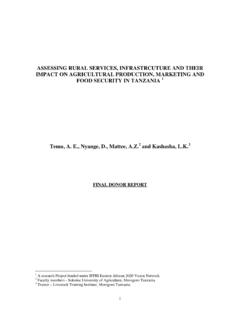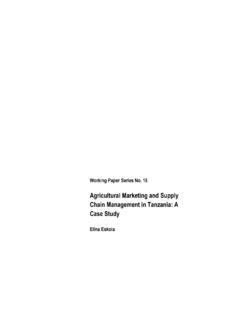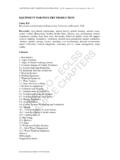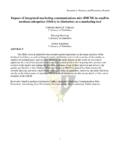Transcription of Food, Fuel, and Freeways - Food Network
1 food , Fuel, and Freeways : An Iowa perspective on how far food travels, fuel usage, and greenhouse gas emissions by Rich Pirog, education coordinator, Leopold Center for Sustainable Agriculture Timothy Van Pelt, student, Iowa State University Agriculture & Biosystems Engineering Kamyar Enshayan, adjunct assistant professor, University of Northern Iowa Ellen Cook, summer intern, Leopold Center for Sustainable Agriculture Leopold Center for Sustainable Agriculture 209 Curtiss Hall Iowa State University Ames, Iowa 50011-1050. Website: June 2001. For more information contact: Rich Pirog, education coordinator Phone: (515) 294-1854. e-mail: Acknowledgements The authors wish to thank the following for their helpful suggestions in reviewing the paper: Rick Hartman, Practical Farmers of Iowa John Hendrickson, Center for Integrated Agricultural Systems, University of Wisconsin- Madison Martin Heller, Center for Sustainable Systems, University of Michigan David Pimentel, Department of Entomology, Cornell University Susan Subak, AAAS Fellow, Environmental Protection Agency Leopold Center staff (M.)
2 Adams, M. Duffy, F. Kirschenmann, L. Miller, J. Neal). Leopold Center summer 2001 interns (Sarah Low and Annette Mathieu). Lorelei F. Pirog Thanks to the following people and organizations who answered questions and provided infor- mation for the paper: Deb Adler, EPA National Vehicle and Fuel Emissions Laboratory Ann Thorp Brouwer, Produce LTD, Oskaloosa Cheryl Bynum, EPA National Vehicle and Fuel Emissions Laboratory Michael Carolan, Iowa State University, Department of Sociology Annika Carlsson-Kanyama, Department of Systems Ecology, Stockholm University, Sweden Roberta Cook, food distribution specialist, University of California-Davis Douglas Edwards, USDA Agricultural Marketing Service, Washington, Robert Ewing, Department of Agronomy, Iowa State University Rick Hartman, Practical Farmers of Iowa Carol Hunt, Johnson County SWCD, Iowa City John Hendrickson, Center for Integrated Agricultural Systems, University of Wisconsin- Madison Phil Kaufman.
3 USDA Economic Research Service, Washington, Gary Lucier, USDA Economic Research Service, Washington, Dwight Minami, California Agricultural Technology Institute, California State University- Fresno Judith Putnam USDA Economic Research Service, Washington, Steve Winders, Loffredo Fresh Produce Co., Inc., Des Moines Thanks to Leopold Center 2001 summer interns Sarah Low and Annette Mathieu for help with the cover page and table of contents. Special thanks to Mary Adams of the Leopold Center for her editorial guidance and counsel. The PDF version of this paper that can be downloaded from the Leopold Center Web page may vary slightly from the printed version available at the Leopold Center. Thanks to Laura Miller and Ken Anderson of the Leopold Center for preparing this paper for the Web.
4 Table of Contents page Executive Summary .. 1. Introduction .. 3. Objectives .. 5. Changes in Iowa's food system .. 6. Energy use in the food system .. 7. Life Cycle Assessment .. 8. Energy costs for marketing and transportation of food products .. 9. food miles the distance food travels from farm to consumer .. 9. Calculating food miles for table grapes using a weighted average source distance (WASD) .. 10. Other uses for the WASD .. 11. Using the WASD to calculate food miles for produce arriving at the Chicago, Illinois terminal market .. 11. Comparison of food miles Iowa local food system examples .. 14. food miles, fossil fuel use, and greenhouse gas emissions .. 14. Comparing fuel use and CO2. emissions for three food distribution systems.
5 15. Discussion .. 18. Application of results: using food miles to estimate fuel use and CO. 2. emission reductions without local data .. 19. Conclusions .. 20. Application of findings to consumers .. 21. Locally grown food as the load less traveled : importance of considering the entire food system .. 22. Recommendations for action .. 22. For Iowa consumers .. 22. For Iowa farmers, retailers, and food brokers .. 23. For food system researchers and educators .. 23. For state and federal policymakers .. 24. Tables page Table 1. Number of commodities produced for sale on at least 1 percent of all Iowa farms for selected years from 1920 to 1997 .. 25. Table 2. Energy use in the food system .. 26. Table 3. Weighted Average Source Distance (WASD) for table grapes with Des Moines, Iowa as consumption point.
6 26. Table 4. Truck WASD estimations, and truck, rail, and foreign arrivals as percent of total 27. Table 5. Distances traveled for three locally grown meals compared to distance if same food items were supplied through conventional channels .. 28. Table 6. Comparison of WASD for food transported to institutions for three Iowa local food system projects with WASD for the same food items sourced from a conventional system .. 30. Table 7. Energy use and emissions for different modes of freight transport .. 31. Table 8. Origin of production states used to estimate 32. Table 9. Estimated fuel consumption, CO2. emissions, and distance traveled for conventional, Iowa-based regional, and Iowa-based local food systems for produce .. 33. Executive Summary Most consumers do not understand today's highly complex global food system.
7 Much of the food production and processing occurs far away from where they live and buy groceries. External environmental and community costs related to the production, processing, storage, and transportation of the food are seldom accounted for in the food 's price, nor are consumers made aware of these external costs. Examples of external environmental costs are the increased amount of fossil fuel used to transport food long distances, and the increase in greenhouse gas emissions resulting from the burning of these fuels. Local and regional food systems, where farmers and processors sell and distribute their food to consumers within a given area, may use less fossil fuel for transportation be- cause the distance from farm to consumer is shorter.
8 This paper discusses transportation from farm to point of sale within local, regional, and conventional food systems. Using fresh produce and other foods as examples, we considered miles traveled, fossil fuels used, and carbon dioxide emissions, and assessed potential environmental costs. A food mile is the distance food travels from where it is grown or raised to where it is ultimately purchased by the consumer or end-user. A Weighted Average Source Dis- tance (WASD) can be used to calculate a single distance figure that combines informa- tion on the distances from producers to consumers and amount of food product trans- ported. Department of Agriculture Agricultural Marketing Service produce arrival data from the Chicago, Illinois terminal market were examined for 1981, 1989, and 1998, and a WASD was calculated for arrivals by truck within the continental United States for each year.
9 Produce arriving by truck traveled an average distance of 1,518. miles to reach Chicago in 1998, a 22 percent increase over the 1,245 miles traveled in 1981. A WASD was calculated for a sampling of data from three Iowa local food projects where farmers sold to institutional markets such as hospitals, restaurants, and confer- ence centers. The food traveled an average of miles to reach its destination, com- pared with an estimated 1,546 miles if these food items had arrived from conventional national sources. Would there be transportation fuel savings and reduction in carbon dioxide (CO2). emissions if more food were produced and distributed in local and regional food sys- tems? To answer this question, we calculated fuel use and CO2 emissions to transport 10.
10 Percent of the estimated total Iowa per capita consumption of 28 fresh produce items for three different food systems. A number of assumptions were used regarding production origin, distance traveled, load capacity, and fuel economy to make the calculations. The goal was for each of the three systems to transport 10 percent by weight of the estimated Iowa per capita consumption of these produce items from farm to point of sale. The conventional system represented an integrated retail/wholesale buying system where national sources supply Iowa with produce using large semitrailer trucks. The Iowa-based regional system involved a scenario modeled after an existing Iowa-based 1. distribution infrastructure. In this scenario a cooperating Network of Iowa farmers would supply produce to Iowa retailers and wholesalers using large semitrailer and midsize trucks.








